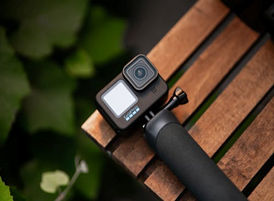
The estoppel provision of the American Invents Act (AIA) (35 U.S.C. § 315(e)(2)) prevents a petitioner in an inter parties review (IPR) proceeding from later raising before the Patent Office, a district court, or the International Trade Commission any invalidity “ground that the petitioner raised or reasonably could have raised” during that IPR. Estoppel attaches when the Patent Trial and Appeal Board (PTAB) issues a final written decision in the IPR. Parties and courts have since debated what the term “grounds” means, and recently in Contour IP Holdings, LLC, v. GoPro, Inc., the Northern District of California determined that GoPro was estopped from raising invalidity defenses based on physical prior art cameras when a final written decision had already been issued rejecting GoPro’s IPR invalidity defenses based on the printed manuals for those cameras.
The dispute arose after GoPro successfully initiated IPR proceedings challenging the validity of two of Contour’s point-of-view digital video camera patents. Contour snapped back by filing an infringement action in district court, and GoPro’s IPRs were ultimately unsuccessful. In the district court action, GoPro raised obvious and invalidity defenses based on physical Sony, Canon, and Nikon cameras (the cameras were excluded from consideration as prior art in the IPR because only patents and printed publications qualify as prior art in those proceedings). Because it was undisputed that the printed manuals for those cameras were available to GoPro (though not used as actual grounds for invalidity) during the earlier IPRs, Contour argued that GoPro was estopped under 35 U.S.C. § 315(e)(2) from asserting the cameras as prior art because manuals describing the cameras were available in the IPRs.
The Court agreed with Contour that the cameras were materially identical to the manuals that were available to GoPro during the IPRs. The Court then turned to whether § 315(e)(2) barred GoPro’s district court invalidity defenses based on the actual cameras. This determination hinged on the interpretation of the term “grounds” in § 315(e)(2), which bars a petitioner from asserting invalidity on any “ground that the petitioner raised or reasonably could have raised” during an IPR. The Court acknowledged that there is a split among district courts over the meaning of “grounds.” Some district courts adopt a broad interpretation, applying estoppel to physical devices described by any patents or printed publications raised in the IPR. Other districts have adopted a narrower view, limiting “grounds” to the specific patents and publications on which the IPR invalidity grounds were based.
The Court adopted the broad interpretation of § 315(e)(2), finding that GoPro’s invalidity prior art theories were estopped because GoPro did not rely on any product specific features of the physical cameras beyond those disclosed in the manuals that were available to GoPro in the IPR. In its decision, the Court emphasized that extending estoppel to bar litigants from asserting physical products as prior art that are materially identical to patents or printed publications available in IPR proceedings “better aligns with the purpose of IPR estoppel as it promotes efficient resolution of patent disputes by preventing repetitive challenges based on slightly rebranded evidence.” The Federal Circuit has not yet weighed in on this precise issue and it remains to be seen whether GoPro will appeal the Court’s decision and put the issue squarely before the Federal Circuit. In the meantime, parties engaged in parallel IPR and district court proceedings should be aware of the district court split and familiarize themselves with any controlling precedent in their jurisdictions to understand whether IPR estoppel may extend to physical devices that are described in patents or printed publications that could have been raised in IPR proceedings. Where a patent challenger finds themselves in a jurisdiction adopting the narrow interpretation of 35 U.S.C. § 315(e)(2), it is imperative that it identifies limitations in the physical device that are not fully described in the printed publication prior art to avoid IPR estoppel. Conversely, when defending against an invalidity challenge based on a physical device in district court, a patentee might identify printed publications available as of the IPR petition date that disclose the same limitations as the device to leverage estoppel based on a parallel IPR proceeding.
